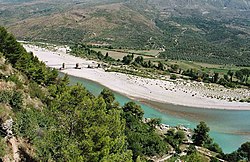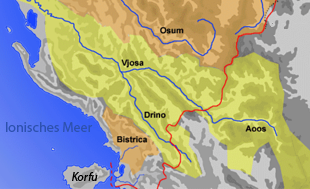| Revision as of 06:41, 6 March 2010 editKhirurg (talk | contribs)Extended confirmed users, Pending changes reviewers, Rollbackers31,699 edits 1) History comes first, the names section is pretty insignificant, 2) Elsie is not cited, Demiraj says *nothing* about the name being Illyrian, 3) empty spaces are unattractive← Previous edit | Revision as of 09:44, 6 March 2010 edit undoMegistias (talk | contribs)Autopatrolled, Pending changes reviewers13,567 edits rv demiraj,Please dont use non-RS SulmuesNext edit → | ||
| Line 33: | Line 33: | ||
| ==Name== | ==Name== | ||
| ⚫ | ''Vjosa'' is a common{{cn}} female ] ]. | ||
| The linguist Shaban DemirajLinguists, excludes the name "Vjose" from Slavic geographical names in Albania. <ref>The origin of the Albanians: linguistically investigated By Shaban Demiraj p153, 154, and 155 </ref> | |||
| ⚫ | ''Vjosa'' is a common female ] ]. | ||
| ==Lists== | ==Lists== | ||
Revision as of 09:44, 6 March 2010
River| Vjosa | |
|---|---|
 | |
| Physical characteristics | |
| Mouth | Adriatic Sea 40°38′34″N 19°19′2″E / 40.64278°N 19.31722°E / 40.64278; 19.31722 |
| Length | 272 kilometres (169 mi) |
Vjosë (Template:Lang-sq) or Aoos (Template:Lang-el), (Template:Lang-la) is a river in northwestern Greece and southwestern Albania. It is also known as Vovousa (Template:Lang-el) or Aias (Template:Lang-el).
Its total length is about 272 kilometres (169 mi), of which the first 80 kilometres (50 mi) are in Greece, and the remaining 192 kilometres (119 mi) are in Albania. Vjosë is fed by two secondary branches, both in Albania, the Drino river and the Shushicë.
Its source is in Greece, specifically in the Pindus mountains, in Epirus, near the village Vovousa. An artificial lake has been constructed at an altitude of 1350 metres, and there is a hydroelectric dam in place since 1987. It flows through the Vikos-Aoos National Park, where it forms impressive canyons. It flows through Konitsa, and enters Albania near Çarshovë. It continues northwest through Përmet, Këlcyrë, Tepelenë, Memaliaj, Selenicë and Novoselë. It flows into the Adriatic Sea, northwest of Vlorë.
Human History
Hecataeus (550 - 476 BC) refers to the river as Aias (Template:Lang-el). The name Anios (Template:Lang-el) is used by Plutarch in Caesar, while Polybius, Livy and Strabo use the term Aoos. The Thesprotian tribe of Parauaioi received their name from the river, as those living beside it. Pausanias writes of "sharks" (Template:Lang-el) in the river, as it flows through Thesprotia. It is mentioned as Auos (Template:Lang-el) by Stephanus of Byzantium in the 6th century AD.
In 198 BC, Philip V of Macedon and the Roman Titus Quinctius Flamininus, clashed in the Battle of the Aous. At 170 BC a plot to kidnap Aulus Hostilius Mancinus was foiled by Molossians by mistake. There are some indications that a river harbour may have existed in Vjosë. In antiquity the river passed more to the north, towards where Fier nowadays lies. Owing to an earthquake in the 4th century AD, it changed to the present course. This earthquake and river change were the main reasons that led to the decline of the ancient Greek city of Apollonia.
Greece

The Vikos-Aoos National Park (Template:Lang-el Ethnikós Drymós Víkou-Aóou), founded in 1973 is a national park in the periphery of Epirus in northwestern Greece. The national park encompasses 126 square kilometres (31,135 acres) of mountainous terrain, with numerous rivers, lakes, caves, deep canyons and dense coniferous and deciduous forest. The core of the park (3400 hectares) is the Vikos Gorge, carved by the Voidomatis river, while Aoos gorge, mount Tymfi, with its highest peak Gamila 2,497 metres (8,192 ft) and a number of traditionally preserved settlements form the park's peripheral zone.
Albania

The hydropower potential of the river is being studied by the Albanian Government. Seven hydroelectric power plants along the Albanian part of the river would have 400 MW total capacity (2,155 GWh/year). The feasibility of the project is being studied. In February 2005 The Albanian Government approved a law, making the Vjose-Narte wetlands a protected area. This legislation followed Albania's ratification of the Kyoto Protocol in December 2004. The river is known for its apport to the important irrigation canal Vjosë-Levan-Fier, a canal that was built in the 50's for the the irrigation of the Myzeqe low plains.
Name
Vjosa is a common female Albanian given name.
Lists
- Tributaries: Drino, Shushicë
- Cities and towns (in upstream order) along with the river: Novoselë, Selenicë, Memaliaj, Tepelenë, Çarshovë, Këlcyrë, Përmet, Konitsa and Vovousa.
- List crossings of the river: Konitsa bridge
Map

See also
- Battle of the Aous
- List of rivers of Albania
- List of rivers of Europe
- List of rivers of Greece
- Vikos-Aoos National Park
References
- Λαμπρίδης Ιωάννης "Ζαγοριακά", Τυπογραφείον Αυγής, Αθήνα, 1870
- Λαμπρίδης Ιωάννης "Ζαγοριακά", Τυπογραφείον Αυγής, Αθήνα, 1870
- Acta hydrochimica et hydrobiologica
- Epirus Vetus: the archaeology of a late antique province
- Egnatia Municipality
- Dictionary of Greek and Roman Geography (1854)
- Paus. 4.34,"But the rivers of Greece contain no terrors from wild beasts, for the sharks of the Aous, which flows through Thesprotia, are not river beasts but migrants from the sea."
- Ethnica Epitome,"Παρά τον Αύον ποταμόν"
- A History of Macedonia: 336-167 B.C by Nicholas Geoffrey Lemprière Hammond,Frank William Walbank,1988,ISBN-0198148151,page 520
- An Inventory of Archaic and Classical Poleis: An Investigation Conducted by The Copenhagen Polis Centre for the Danish National Research Foundation by Mogens Herman Hansen,2005,page 329
- Trakolis: p. 3
- Project from Energy Community not-for-profit
- UN Environment Programme's website last retrieved 3/4/2010
- View from Geonames website.
This article about a specific Albanian location is a stub. You can help Misplaced Pages by expanding it. |
This Greece location article is a stub. You can help Misplaced Pages by expanding it. |